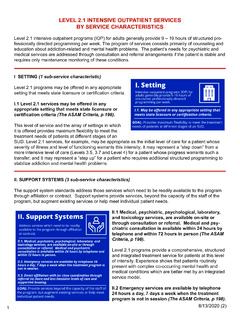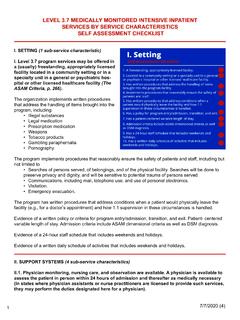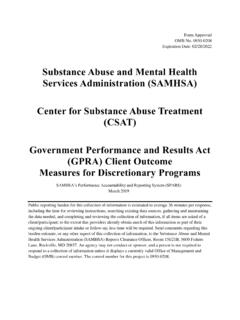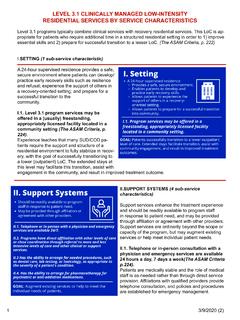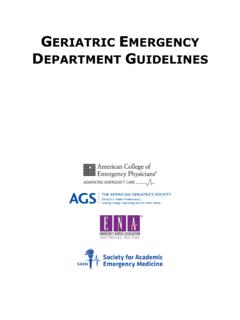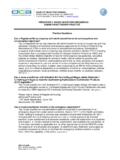Transcription of LEVEL 1 OUTPATIENT SERVICES BY SERVICE CHARACTERISTICS
1 LEVEL 1 OUTPATIENT SERVICESBY SERVICE CHARACTERISTICSL evel 1 programs typically provide professionally directed screening, evaluation, treatment, and ongoing recovery and disease management SERVICES in a wide variety of settings. Such SERVICES are provided in regularly scheduled sessions of (usually) fewer than nine contact hours a week for adults. The SERVICES follow a defined set of policies and procedures or clinical SETTING (1 sub- SERVICE characteristic) LEVEL 1 programs deliver SERVICES in office practices, health clinics, primary care clinics, addiction program, and mental health LEVEL 1 SERVICES may be offered in any appropriate setting that meets state licensure or certification criteria (The ASAM Criteria, p 187).This LEVEL of SERVICE and the array of settings in which it is offered provides maximum flexibility to meet the treatment needs of patients at different stages of an SUD. LEVEL 1 SERVICES for example may be appropriate as the initial LEVEL of care for a patient whose severity of illness and LEVEL of functioning warrants this intensity; it may represent a step down from a more intensive LEVEL of care for a patient whose progress warrants such a transfer; and it may be used for patients who have achieved stability in recovery but need monitoring and disease management indefinite-ly as is done with other chronic diseases such as hypertension, diabetes and SUPPORT SYSTEMS (3 sub- SERVICE charac-teristics)The support system standards address those SERVICES which need to be readily available to the program through affiliation or contract.
2 Support systems provide SERVICES , beyond the capacity of the staff of the program, but augment existing ser-vices or help meet individual patient Medical, psychiatric, psychological, labora-tory, and toxicology SERVICES , are available on-site or through consultation or referral. Medical and psychiatric consultation is available within 24 hours by telephone or, if in person, within a time frame appropriate to the severity and ur-gency of the consultation requested (The ASAM Criteria, p 187). LEVEL 1 programs provide a comprehensive and integrated treatment SERVICE for patients at this LEVEL of intensity. Experience shows that patients routinely present with complex co-occurring mental health and medical conditions which are better met by an 14/27/2020integrated SERVICE Direct affiliation with (or close coordination through referral to) more intensive levels of care and medication management (The ASAM Criteria, p 187). LEVEL 1 should be viewed in the context of a large network of LoCs that can meet the needs of patients at varying stages of treatment.
3 The program should establish relationships with providers to permit smooth, ideally seamless transitions between levels, according to patient status as determined by the ASAM Emergency SERVICES are available by telephone 24 hours a day, 7 days a week (The ASAM Cri-teria, p 187). LEVEL 1 programs make emergency and crisis SERVICES for patients available by telephone 24 hours a day, 7 days a week to assist in stabilizing crisis situations and maintain the patient in LEVEL 1 STAFF (3 sub- SERVICE CHARACTERISTICS )ASAM staff standards address the composition and competencies of professionals on the staff of the Certified and/or licensed addiction counselors offer much of the counseling in LEVEL I SERVICES , but medication management (pharmacotherapy) SERVICES are LEVEL 1 SERVICES and require the involvement of a licensed independent practitioner with prescribing authority as granted by state-based licensing boards (The ASAM Criteria, p. 187). LEVEL 1 OUTPATIENT SERVICES are best delivered by clinicians with the education, training and exper-tise to intervene using empirically based clinical SERVICES with the support and involvement of a licensed medical Office based nurses (RN s and LPN s) are often involved with medication management in support of prescribers.
4 They provide patient education about medications and optimize patient adherence and treatment retention with OUTPATIENT medication management (The ASAM Criteria, p. 187 188). LEVEL 1 SERVICES support the full range of addiction pharmacotherapies for patients and experience demonstrates that ongoing patient education is crucial to the effectiveness of these interventions. Addiction specialist physicians provide LEVEL 1 SERVICES for medication management or integrated psychosocial SERVICES /medication management in referral from generalist physicians, mental health professionals, or certified and/or licensed addiction counselors when the 24/27/2020complexity of the case or problematic previous treatment response warrant the involvement of the most highly skilled clinician available (The ASAM Criteria, p. 188).A qualified addiction specialist physician is an integral part of providing comprehensive LEVEL 1 SERVICES and serves as Medical Director, with responsibilities that include oversight of care as well as supervision of other physicians or licensed practitioners with prescribing THERAPIES (3 sub- SERVICE CHARACTERISTICS )ASAM therapies standards cover the range of therapies that programs need to be capable of offering to ensure they meet the personalized biopsychosocial needs of the patients they treat.
5 Not all listed therapies must be provided to each person served, but the program should have the capacity to provide each of these as LEVEL 1 SERVICES are skilled treatment SERVICES , which may include individual and group counseling, motivational enhancement, family therapy, educational groups, occupational and recreational therapy, psychotherapy, addiction pharmacotherapy, or other therapies. Such SERVICES are provided in an amount, frequency, and intensity appropriate to the patient s multidimensional severity and LEVEL of functioning (The ASAM Criteria, p. 188). LEVEL 1 programs provide a wide range of therapies that are fit to the patient s assessed multidimensional needs, to create an individualized treatment plan that varies in amount, frequency and intensity to match the patient s progress in treatment. Experience has shown the value of a wide range of treatment SERVICES at this LEVEL of care to optimize the response to Motivational enhancement and engagement strategies are used in preference to confrontational therapies (The ASAM Criteria, p.)
6 188).Rather than confrontation, an approach based in motivational enhancement can be tailored to the patient s stage of change and result in an improved response to For patients with mental health conditions, the issues of psychotropic medication, mental health treatment, and their relationship to substance use and addictive disorders are addressed as the need arises (The ASAM Criteria, p. 188). LEVEL 1 programs provide integrated clinical SERVICES and routinely address mental health conditions and their relationship to SUDs as the need arises. This approach better fits individualized treatment planning, minimizes disruptions to care for patients when a particular mental health need arises, and optimizes the response to ASSESSMENT/TREATMENT PLAN REVIEW (4 sub- SERVICE CHARACTERISTICS )These sub- SERVICE CHARACTERISTICS address assessment of the patient for treatment. Identification of biopsychosocial needs, strength, deficits, problems and limitations are integral to the formation of the individual treatment standardized multidimensional assessment and treatment planning process is used.
7 The goal is to establish and maintain relevance to the patient s status as it changes during the course of treatment. The focus is on the patient s overall progress on goals and objectives rather than the confines of a treatment LEVEL 1 assessment and treatment plan review include an individual biopsychosocial assessment of each patient, which includes a comprehensive substance use and addictive disorders history obtained as part of the initial assessment and reviewed by a physician, if necessary (The ASAM Criteria, p. 189).Through a comprehensive assessment of the patient s biopsychosocial status and SUD needs, including a physician review as necessary, appro-priateness for LEVEL 1 SERVICES is established, and a foundation is laid for an individualized treatment LEVEL 1 assessment and treatment plan review may include a physical examination performed within a reasonable time, as determined by the patient s medical condition. Such determinations are made according to established protocols, which include reliance on the patient s personal physician whenever possible.
8 (In states where physician assistants or nurse practitioners are under physician super-vision and are licensed as physician extenders, they may perform the duties designated here for a physician) (The ASAM Criteria, p. 189).A physical examination in response to evolving patient needs may provide valuable information for use in treatment LEVEL 1 assessment and treatment plan review includes an individualized treatment plan, which involves problems, needs, strengths, skills and priority formulation. Short-term, measurable treatment goals and preferences are articulated along with activities designed to achieve those goals. The plan is developed in collaboration with the patient and reflects the patient s personal goals. Treatment plan reviews are conducted at specified times, as noted in the plan, or more frequently as determined by the appropriate credentialed professional (The ASAM Criteria, p. 189).Treatment is patient-directed based on assessment, with the clinician in the role of guide and facilitator.
9 The individualized plan features measurable objectives to be addressed during the course of treatment, 44/27/20204and reflects the patient s stated LEVEL 1 assessment and treatment plan review include monitoring biomarkers and/or toxicolo-gy testing (The ASAM Criteria, p. 189).Urinalysis and/or toxicology tests provide important and empirical evidence of the appropriateness and effectiveness of an individual treatment plan and should be considered in any assessment and treatment review process. VI. DOCUMENTATION (2 sub- SERVICE CHARACTERISTICS )ASAM documentation standards detail the expectations regarding the individualized patient information that needs to be captured to ensure optimal patient Documentation standards for LEVEL 1 programs include individualized progress notes in the patient s record that clearly reflect implementation of the treatment plan and the patient s response to therapeutic interventions for all disorders treated, as well as subsequent amendments to the plan (The ASAM Criteria, p.)
10 189).The primary method for documenting progress is through regular notes that describe the implementation of the treatment plan, patient response to interventions and any amendments made. Notes should be timely, complete and accurate, in accordance with established policies and Treatment plan reviews are conducted at specified times and recorded in the treatment plan. To ensure the patient is making progress on treatment plan objectives and to document appropriateness for this LoC, formal reviews using the six ASAM dimensions should occur at specified intervals, or as needed. The review process, its findings, and any amendments to the plan are


